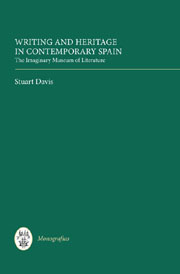Book contents
- Frontmatter
- Contents
- Acknowledgements
- Introduction
- 1 Presenting the Museum
- 2 Never-ending Story: Canon Fever
- 3 Working Models, Model (Re)Workings: Goytisolo and Cervantes
- 4 The Authoritative Gaze: Cristina Peri Rossi
- 5 Generations Apart? The ‘Generation X’ in Spanish Literature
- Conclusion: What do we do with the Gifts of the Past?
- Works Cited
- Index
3 - Working Models, Model (Re)Workings: Goytisolo and Cervantes
Published online by Cambridge University Press: 05 February 2013
- Frontmatter
- Contents
- Acknowledgements
- Introduction
- 1 Presenting the Museum
- 2 Never-ending Story: Canon Fever
- 3 Working Models, Model (Re)Workings: Goytisolo and Cervantes
- 4 The Authoritative Gaze: Cristina Peri Rossi
- 5 Generations Apart? The ‘Generation X’ in Spanish Literature
- Conclusion: What do we do with the Gifts of the Past?
- Works Cited
- Index
Summary
cuando algún pintor quiere salir famoso en su arte, procura imitar los originales de los más únicos pintores que sabe; y esta mesma regla corre por todos los más oficios o ejercicios de cuenta que sirven para adorno de las repúblicas
Miguel de Cervanteswhen nature instituted the faculty of remembrance, she did not tie herself exclusively to the possibility of direct and indirect memories; she also gave, to clever and foolish alike, the power of cryptomnesia.
Carl JungVisit: Museo Casa Natal de Cervantes
Lying just over twenty miles north of Madrid, the city of Alcalá de Henares (motto: ‘Ciudad del saber’) attracts thousands of visitors every year who relish the World Heritage Site status of the city centre, the famous ancient university and its literary associations. Alcalá boasts of being the birthplace of several famous Spaniards, including royals (such as Henry VIII's first wife, Catherine of Aragón), the painter Eugenio Lucas Velázquez and writers such as the Arcipreste de Hita (Juan Ruiz) and one Miguel de Cervantes Saavedra, after whom the tourist train from central Madrid is named. Although it is widely held that the Golden Age writer and most renowned author in Hispanic letters only lived in Alcalá for the first few years of childhood, before moving to Valladolid, Alcalá celebrates the anniversaries of both his birth, with festivities during Semana Cervantina, and his death, when the king awards the Premio Cervantes at Alcalá's University.
- Type
- Chapter
- Information
- Writing and Heritage in Contemporary SpainThe Imaginary Museum of Literature, pp. 74 - 110Publisher: Boydell & BrewerPrint publication year: 2012



